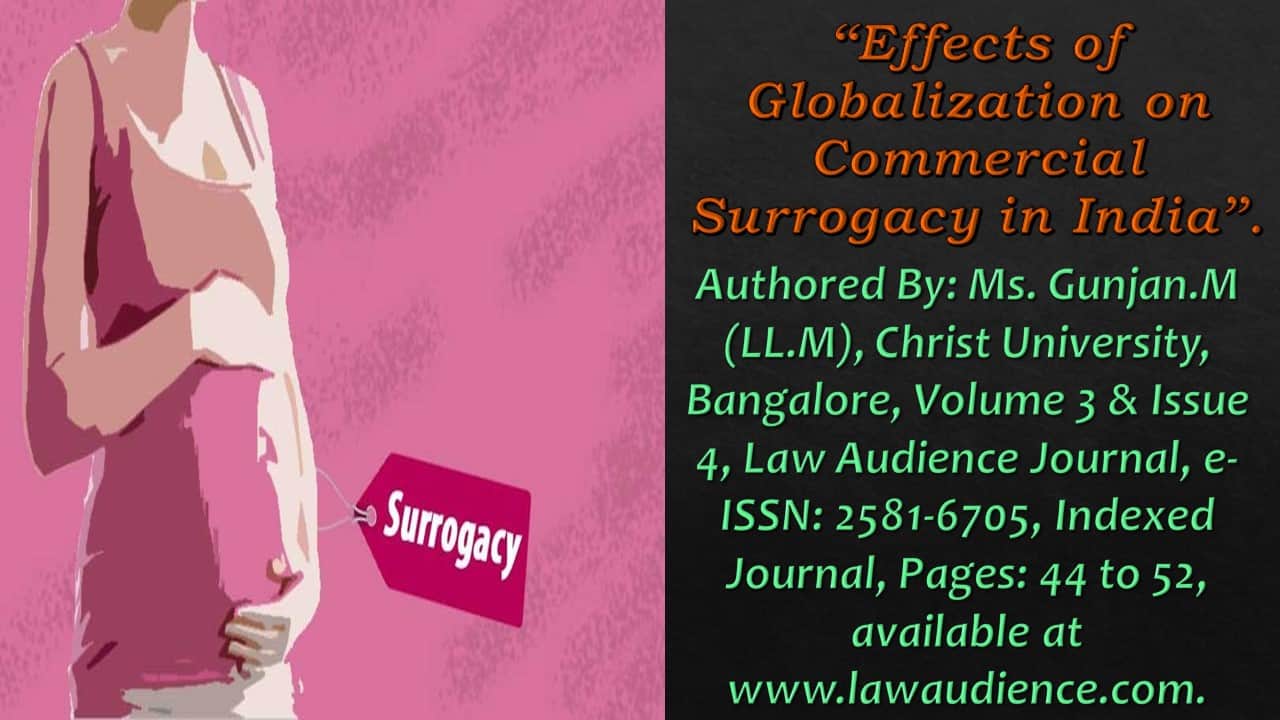Click here to download the full paper (PDF)
Authored By: Ms. Gunjan.M (LL.M), Christ University, Bangalore,
Click here for Copyright Policy.
I. INTRODUCTION:
Parenting and Parenthood is an important aspect of an individual’s life. Surrogacy is a life boon for such couples who are unable to conceive owing to certain physiological defects. The procedure of globalization has played a significant role in the evolution and growth of commercial surrogacy, significantly in India. Since India provides for cost effective and illiterate surrogate mothers with less bargaining power, the foreign couples tend to approach and be willing to travel to India and involve themselves through such a process by contractual arrangement. It can be said that such a process can provide economic benefits to the surrogate mother, plus leads to their exploitation. The most recent attempt of the government on commercial surrogacy challenges is addressed in the Draft Surrogacy (Regulation) Bill of 2020. Nonetheless, the 2020 Bill seeks to prohibit commercial surrogacy of any form and regulate altruistic surrogacy to a great extent. Considering this, the current study aims to analyze the effects of globalization on commercial surrogacy with the extent to which the 2020 Bill addresses the issues relating to commercial surrogacy in India.
II. MEANING OF SURROGACY:
Life as a parent frames a significant part of a singular’s life. Be that as it may, in specific circumstances, a few face issues in conceiving a child owing attributable to specific natural imperfections in one or the other or both the accomplices. Surrogacy as well as in-vitro fertilization[1] (alluded to as IVF in the future), as a clinical practice, started with the possibility that such couples should likewise have the option to partake in the joys of being a parent. The literal meaning of surrogacy is ‘to substitute’. The Indian Council for Medical Research (ICMR) has defined surrogacy as “an arrangement where a woman agrees to carry a pregnancy that is genetically unrelated to her and her husband, with the intention to carry term and hand over the child to the genetic parents for whom she is acting as a surrogate.”[2] The procedure of surrogacy involves an agreement between the surrogate mother i.e. the woman who carries the fetus in her womb till delivery, and the commissioning parents[3] i.e. the couple who is genetically related to the child shall be born out of surrogacy. Assisted reproductive technology (referred to as ART hereafter) is the technology used to treat infertility in both men and women. IVF, oocyte and sperm donation, intrauterine insemination (IUI)[4], cryopreservation[5] and surrogacy, all form a part of ART itself.
In view of the oocyte (egg) utilized, surrogacy is characterized into conventional and gestational. In conventional surrogacy, incipient organism is made utilizing the egg of the proxy mother herself, alongside the sperm of the dispatching male accomplice. Then again, in gestational surrogacy, undeveloped organisms are made by blending the egg and sperm of the dispatching guardians for example the youngster will be hereditarily connected with both the guardians. The incipient organism is then embedded into the uterus of the substitute mother. In view of the pay to be paid to the proxy mother, surrogacy is delegated business or charitable. In selfless surrogacy, remuneration to the proxy mother is limited to simple clinical expenses and other pregnancy-related sensible costs. Nonetheless, in business surrogacy, alongside the repayment for clinical expenses and other pregnancy related sensible costs, the proxy mother is likewise paid an extra amount of cash as remuneration for conveying the offspring of the authorizing guardians. This extra amount of cash baits helpless ladies into surrogacy arrangements.
III. THE PROCESS OF COMMERCIAL SURROGACY IN INDIA:
The increase of technology, globalization, the lack of legal regulatory framework, and the availability of cheap and illiterate women, coupled with certain other factors has made India a hotspot destination for commercial surrogacy. Transnational commercial surrogacy has also helped in defining certain key steps involved in the process. Surrogacy is often defined as “a relationship of mutual understanding and generosity between the surrogate and the infertile couple”[6] Nonetheless, one can’t disregard the way that business surrogacy is basically a business, and is purchaser driven. In India, surrogacy is for the most part administered by the agreement entered between the proxy mother and the charging guardians. It is critical to take note of that when the substitute’s way of life as a mother is represented by a contract, being a decent mother frequently clashes with being a decent provisional laborer. The cycle of accomplishing a harmony between the two includes different advances. The significant steps have been mentioned below:
- Employing prospective surrogate mothers.
- Formation of Contract between natural guardian and the surrogate mother.
- Origination of pregnancy and the job of Surrogacy Hostels.
IV. EFFECTS OF GLOBALIZATION ON COMMERCIAL SURROGACY:
According to the global perspective, surrogacy is by & large prohibited in nations like Australia[7],China[8], France, Germany, Italy, Spain,[9] and a few conditions of the United States of America[10]. Nations like Brazil[11], and the United Kingdom[12], then again, have forced a halfway restriction on the act of surrogacy, while nations like India, and Greece[13], have no guidelines by any means. It is relevant to note that surrogacy is anything but a home-grown practice. Transnational Commercial Surrogacy[14] is particularly practically speaking in the current day. Globalization, innovative headway in the clinical business and expanded portability of individuals across the globe have extended and adjusted the standard suppositions and originations of family, connection and parenthood.[15] Transnational commercial surrogacy is done where:
- Where there is a complete prohibition on the practice of commercial surrogacy or surrogacy per se;
- Commercial surrogacy is still stringently regulated by the government, even though it is not banned;
- The cost of commercial surrogacy process is high in the country where the involving parents reside as compared to the place where the prospective surrogate mother resides;
Major effects of globalization on commercial surrogacy in India has the following implications:
- India becoming a hub of commercial surrogacy;
- The exploitation of women in India who agree/ contract to act as surrogate mothers under the transnational commercial surrogacy procedure.
- The subsequent initiatives of the government to curb the menaces related to commercial surrogacy.
V. ISSUES RELATED TO COMMERCIAL SURROGACY IN INDIA:
At the point when any plan happens cross-country, having a legitimate administrative system becomes basic to guarantee that the weak party to such a course of action isn’t taken advantage of by the other party, who is in a superior position. With regards to transnational business surrogacy, the proxy mother is the weak party, and the charging guardians are in a superior position, both monetarily and in any case (as far as power, impact, instruction and so forth) Furthermore, whenever the whole plan of business surrogacy is administered by a surrogacy arrangement where the proxy mother can’t comprehend the terms of arrangement and deal, issues are should emerge. The following issues are;
- The issue arises with respect to recruiting surrogate mothers. The clinics which enjoy the dominant position add the layer of power dynamics and often use this position to brainwash the poor, uneducated women through what they refer to as “counselling sessions” to carry on with the pregnancies in the nature of a pious deed.[16] They are often not made aware of the implications involved in the process, their rights and remedies available to them. This leads to direct exploitation of such women.
- The next issue which emerges from commercial surrogacy is concerning the surrogacy understanding. The understanding is principally in English and is drafted by the appointing guardians, who in this manner have an advantage in the game plan. Further, however a couple of fundamental focuses are deciphered for the substitute mother, these focuses by and large connect with her commitments towards the appointing guardians. This disables the place of the proxy moms who are just well-versed with their local language and can’t bargain for themselves.
- This issue is in relation to the previous issue, that is at the point when the surrogate mother can’t see every single part of the understanding she is going into, is it conceivable to say that there is agreement promotion idem? In the event that not, then, at that point, how is the agreement even enforceable?
- The resulting issues emerge regarding the youngster conceived out of such game plan, for example what would occur assuming that the kid is brought into the world with some handicap, physical or mental[17]; what might occur assuming that the sex of the youngster is not quite the same as what the authorizing guardians so wanted; what might occur on the off chance that the authorizing guardians choose not to take the kid attributable to the previous reasons for sure assuming that the dispatching guardians separate during the growth time frame and along these lines, no one will take the guardianship of the youngster conceived out of surrogacy?
VI. BACKGROUND:
Since the 2000s, India has turned into a top objective for worldwide business surrogacy[18],with the town of Anand in Gujarat being famously called the ‘cradle of the world’. In 2012,in excess of 25,000 kids were assessed to be brought into the world by surrogacy in India, out of which a big part of the surrogacies was recorded to be completed for worldwide parents[19].
There are a list of reasons why India is preferred over other nations for transnational commercial surrogacy. Firstly, till to date, there is no particular legal regime governing surrogacy in India[20]. The surrogacy arrangement is governed by the surrogacy agreement, which the surrogate mother and the commissioning parents are a party to. Secondly, surrogacy procedures are much simplified and affordable in India than anywhere else in the world. The cost of availing commercial surrogacy in India is almost one third of the cost in the United States of America[21] .
This is further combined with the fact that women in India who choose to become surrogate. Mothers are mostly poor, illiterate and easily available, and therefore, have no bargaining power. They barely understand the terms of the agreement they enter into and agree to go through the procedure at whatever price the commission parents or their agent’s quote. The Indian government, in the year 2015 delivered a round expressing that the global appointing couples can’t visit India on traveller visa with the end goal of surrogacy. Other rules of clinical tourist visa[22] was formed to draw in global reproductive tourists[23]. Therefore, these reasons coupled together make India one of the most sought-after destinations in the world for commercial surrogacy.
VII. METHODOLOGY:
The study employs the doctrinal method of research in order to offer an analysis of the effects on globalization by commercial surrogacy by making use of data already available in public domain. For the purpose of determining whether terrorism is a global threat this research will make use of primary sources such as domestic and international legislations; rules and guidelines, international instruments such as agreements, treaties and conventions.
Secondary sources such as journals, periodicals, monographs articles, conference papers are to be referred, also books, book chapters, working papers and discussion papers in the course of research for the purpose of determining what situations.
VIII. THE DRAFT SURROGACY (REGULATION) BILL, 2020: A CRITICAL ANALYSIS:
The Bill discusses both commercial[24] as well as altruistic surrogacy[25]. It just permits charitable surrogacy[26] and forbids a wide range of surrogacy for any business purposes[27]. The Bill additionally confines the choice of unselfish surrogacy to the aiming two or three Indian beginning, who has an ailment requiring gestational surrogacy[28], as well as an expecting lady of Indian beginning who is widow or divorced person, matured between 35-45 years. The Bill further denies sex determination procedures[29] in surrogacy.
The Bill provides that the kid conceived out of the surrogacy course of action “will be considered as a organic offspring of the meaning couple or the aiming lady”[30]. Further, the Bill accommodates the necessity of “composed informed assent”[31] from the proxy mother in the wake of clarifying all known aftereffects and eventual outcomes associated with the surrogacy strategy. Additionally, every one of the directions should be given and the methodology ought to be completed in the language which the proxy mother understands.[32] The bill denies the demonstration of leaving the couple conceived out of surrogacy by the aiming couple or then again, the expecting lady inferable from the reasons like hereditary deformity, birth imperfection, some other clinical condition, sex of the youngster or origination of more than one baby[33] and furthermore forbids forced abortion[34].
In addition to this the bill gives insurance coverage for surrogate mothers has been increased to 36 months.[35] It further contains provisions for establishing National Surrogacy Board[36] at the national level and, State Surrogacy Board,[37] at state level.
Regarding the issue of complete prohibition on commercial surrogacy in India as well as the prohibition of specific classes of grown-up people from profiting the advantages of surrogacy, a plenty of cases have laid out that the right to reproduction independence as a piece of right to life and individual freedom under Article 21 of the Constitution of India.
The Apex Court in Suchita Srivastava v. Chandigarh Administration[38] observed that a woman’s right to make reproductive choices has been interpreted as a dimension of ‘personal liberty’ as understood under Article 21. The most recent and the much-celebrated case of Justice K.S. Puttaswamy v. Union of India also reiterated that the reproductive choices of the women is a significant aspect of personal liberty under Article 21 of the Constitution of India.
IX. CONCLUSION:
A harmony between the privileges of aiming couple and the freedoms of a proxy mother, in the setting of transnational business surrogacy, can accomplished by set down express arrangements which require taking informed assent and guaranteeing that both the gatherings to the surrogacy contracts are on similar balance concerning the authorization of their rights and privileges under the agreement. A compelling consistency instrument can be effective in controlling the ‘manipulative’ part of transnational commercial surrogacy.
The Bill further makes a stride further and disregards the freedoms of the aiming couple/person by restricting the meaning of ‘aiming couple/lady’ and making it subject to certain preposterous circumstances.
Subsequently, albeit the Bill of 2020 has endeavoured to defend the freedoms and interests of the couple conceived out of surrogacy, be that as it may, the privileges and interests of the proxy mother, too as the expecting couple/individual have plainly been compromised with.
Cite this article as:
Ms. Gunjan.M, “Effects of Globalization on Commercial Surrogacy in India”, Vol.3 & Issue 4, Law Audience Journal (e-ISSN: 2581-6705), Pages 44 to 52 (4th March 2022), available at https://www.lawaudience.com/effects-of-globalization-on-commercial-surrogacy-in-india/.
Footnotes & References:
[1] IVF or in vitro fertilization uses scientific techniques to help sperm fertilize an egg, and help the fertilized egg to be implanted in the uterus of the woman.
[2] INDIAN COUNCIL OF MEDICAL RESEARCH, http://icmr.nic.in/art/ art_clinics.htm (last visited Feb.2, 2022)
[3] LAWINSIDER, https://www.lawinsider.com/dictionary/commissioning-parent (last visited Feb. 3, 2022).
[4] The process of placing the sperm directly in the uterus of the woman during her ovulation.
[5] Process of keeping the live cells, tissues and other biological samples in a deep freeze for the purpose of preservation.
[6] Pranav Rao, Analysis of surrogacy laws in India, 4 INTERNATIONAL JOURNAL OF ADVANCE RESEARCH, IDEAS AND INNOVATIONS IN TECHNOLOGY, (2018).
[7] SARAH JEFFORD, https://sarahjefford.com/surrogacy-laws-in-australia/ (last visited Jan. 28, 2022).
[8] CHINA.ORG, http://www.china.org.cn/english/2001/Jun/15215.htm (last visited Jan. 28, 2022).
[9]EURONEWS,https://www.euronews.com/2018/09/13/where-in-europe-is-surrogacy-legal (last visited Jan.28, 2022).
[10]SURROGATE.COM,https://surrogate.com/intended-parents/surrogacy-laws-and-legal-information/surrogacy-laws-by-state/ (last visited Jan. 28, 2022).
[11] BABYGEST, https://babygest.com/en/surrogacy-in-brazil/ (last visited Jan.28, 2022).
[12]INDEPENDENT,https://www.independent.co.uk/life-style/surrogacy-uk-cost-it-legal-how-work-baby-kimkardashian-a8907461.html (last visited Jan. 28, 2022).
[13] IMTJ, https://www.imtj.com/news/surrogacy-market-greece-working/ (last visited Jan. 28, 2022).
[14] Transnational commercial surrogacy is a form of medical tourism undertaken by intended parents who seek to hire women in other countries, increasingly often in the global South, as surrogates.
[15] Prasanna Mohanty, The Surrogacy (Regulation) Bill 2019: A Casual Approach to a Serious Concern, BUSINESS TODAY(Jan.25,2022,12:27PM),https://www.businesstoday.in/search.jsp?searchword=PrasannaMohanty&searchtype=text&searchphrase=exact&search_type=author.
[16]RESEARCHGATE,https://www.researchgate.net/publication/340443765_SURROGACY_REGULATION_BILL_2019_A_CRITIC AL_APPRAISAL (last visited Jan. 28, 2022).
[17]TIMES OF INDIA, http://timesofIndia.indiatimes.com/india/Aussie- couple-abandoned-surrogate-baby-in India/articleshow/44766805.cms (last visited Jan. 28, 2022).
[18] Rozée and Unisa, Surrogacy as a Growing Practice and a Controversial Reality in India: Exploring New Issues for Further Researches, 4(6) JOURNAL OF WOMENS HEALTH ISSUES AND CARE, 1-7 (2015).
[19] P Shetty, India’s unregulated surrogacy industry, LANCET, (2012).
[20] There have been a few proposed bills.
[21] S S Das and Priyanka Maut, Commercialization Of Surrogacy In India: A Critical Analysis, RESEARCHGATE (2016),researchgate.net/publication/281710247_Commercialization_of_Surrogacy_in_India_A_Critical_Analys is#read.
[22] Circular no. 242 of 2015, by the Ministry of Home Affairs.
[23] A Donchin, Reproductive tourism and the quest for global gender justice, 24(7) BIOETHICS, 323- 332 (2010).
[24] Section. 3(5)(b).
[25] Section. 2(b).
[26] Section.4(ii)(b).
[27] Section. 4(ii)(c).
[28]Section.4(ii)(a).
[29] Section. 3(viii).
[30] Section.8.
[31] Section. 6.
[32] Id.
[33] Section 8.
[34] Section 10.
[35] Section 4, Explanation III.
[36] Section 15.
[37] Section 24.
[38] Justice K.S. Puttaswamy v. Union of India, (2009) 9 SCC (1).





